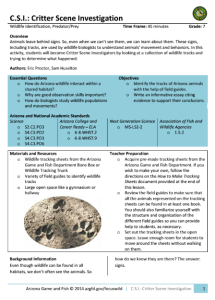 Even though wildlife can be found in all habitats, we don’t often see the animals. So, how do we know they are there? The answer: signs.
Even though wildlife can be found in all habitats, we don’t often see the animals. So, how do we know they are there? The answer: signs.
Animals often leave behind signs that they have been active. These can include chewed leaves, burrows, and scat. An important sign is tracks or footprints. People have always used these tracks and other signs to locate prey and to study animal movement and behavior. Even as technology advances, traditional tracking still plays an important role in wildlife management.
In this lesson, students will have the opportunity to analyze various wildlife scenes to determine what happened. They will not have the luxury of seeing any animals. They must review the signs, primarily tracks, that are left behind to determine what happened. They will become Critter Scene Investigators.
The lesson is available as a downloadable PDF that includes ideas to extend and modify the lesson for different audiences.
For a different activity that explores animal signs, check out the related Focus Wild activity.
ESSENTIAL QUESTIONS
- How do Arizona wildlife interact within a shared habitat?
- Why are good observation skills important?
- How do biologists study wildlife populations and movements?
STANDARDS CORRELATION
This lesson has been correlated to the following Arizona Department of Education academic standards:
Science – 7th Grade
- S2.C2.PO3
- S4.C3.PO2
- S4.C3.PO3
- S4.C3.PO6
College and Career Ready – ELA
- 6-8.WHST.2
- 6-8.WHST.9
This lesson is also correlated to the Next Generation Science Standards and the Association of Fish and Wildlife Agencies Standards. Please see the lesson plan for more information.
AUTHOR
Eric Proctor, Wildlife Education coordinator, Arizona Game and Fish Department
Sam Huselton, Wildlife Education Outreach coordinator, Arizona Game and Fish Department

